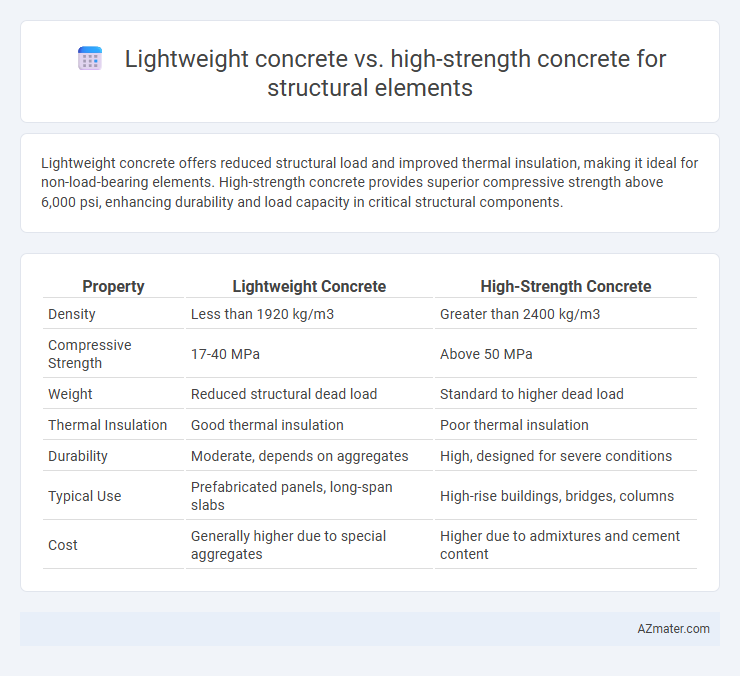Lightweight concrete offers reduced structural load and improved thermal insulation, making it ideal for non-load-bearing elements. High-strength concrete provides superior compressive strength above 6,000 psi, enhancing durability and load capacity in critical structural components.
Table of Comparison
| Property | Lightweight Concrete | High-Strength Concrete |
|---|---|---|
| Density | Less than 1920 kg/m3 | Greater than 2400 kg/m3 |
| Compressive Strength | 17-40 MPa | Above 50 MPa |
| Weight | Reduced structural dead load | Standard to higher dead load |
| Thermal Insulation | Good thermal insulation | Poor thermal insulation |
| Durability | Moderate, depends on aggregates | High, designed for severe conditions |
| Typical Use | Prefabricated panels, long-span slabs | High-rise buildings, bridges, columns |
| Cost | Generally higher due to special aggregates | Higher due to admixtures and cement content |
Introduction to Lightweight and High-Strength Concrete
Lightweight concrete, characterized by a density typically less than 1900 kg/m3, uses lightweight aggregates such as expanded clay or shale, reducing the dead load on structural elements and enhancing thermal insulation. High-strength concrete, with compressive strengths often exceeding 40 MPa, incorporates low water-to-cement ratios, silica fume, and superplasticizers to achieve superior durability and load-bearing capacity. Both materials serve distinct structural purposes: lightweight concrete improves seismic performance and energy efficiency, while high-strength concrete enables slender, high-load-bearing columns and beams in advanced construction.
Key Differences in Composition
Lightweight concrete incorporates aggregates such as expanded clay, shale, or pumice, reducing its density to typically between 1,440 and 1,840 kg/m3, while high-strength concrete uses a dense mix of fine aggregates, silica fume, and low water-cement ratios to achieve compressive strengths exceeding 40 MPa. The porous nature of lightweight concrete aggregates results in lower thermal conductivity and reduced dead load on structural elements compared to the denser, highly compacted matrix of high-strength concrete. These compositional differences influence not only density and strength but also impact durability, insulation properties, and structural load capacity in building applications.
Mechanical Properties Comparison
Lightweight concrete typically exhibits lower compressive strength, ranging from 17 to 35 MPa, compared to high-strength concrete, which can exceed 70 MPa, making the latter more suitable for load-bearing structural elements requiring high durability. The reduced density of lightweight concrete, often between 1400 to 1850 kg/m3, enhances thermal insulation and reduces dead load but compromises mechanical properties such as modulus of elasticity and tensile strength. High-strength concrete demonstrates superior mechanical performance with higher modulus of elasticity, better resistance to cracking, and greater bond strength, essential for structural elements subjected to significant stress and dynamic loads.
Structural Performance and Load-Bearing Capacity
Lightweight concrete exhibits lower density and reduced dead load, enhancing structural performance by minimizing seismic forces and foundation requirements, while its load-bearing capacity is generally lower compared to high-strength concrete. High-strength concrete offers superior compressive strength, enabling thinner structural elements and higher load-bearing capacity, suitable for high-rise buildings and heavy-load applications. Optimizing the choice between lightweight and high-strength concrete depends on balancing weight reduction, strength requirements, and overall structural efficiency.
Thermal and Acoustic Insulation Benefits
Lightweight concrete offers superior thermal insulation due to its lower density and higher porosity, effectively reducing heat transfer in structural elements. Its cellular structure also provides enhanced acoustic insulation by absorbing sound waves and minimizing noise transmission compared to high-strength concrete. High-strength concrete, while excellent for load-bearing capacity, typically has lower insulating properties due to its dense composition and limited air voids.
Typical Applications in Structural Elements
Lightweight concrete is commonly used in structural elements such as floor slabs, bridge decks, and precast panels to reduce dead load and improve thermal insulation, making it ideal for long-span structures and seismic zones. High-strength concrete is preferred for columns, beams, and high-rise building cores where enhanced load-bearing capacity and durability are critical for withstanding heavy stresses and compressive forces. Both materials optimize performance in structural elements depending on specific project requirements like load, weight reduction, and environmental conditions.
Durability and Long-Term Performance
Lightweight concrete offers enhanced durability in seismic zones due to reduced structural load and improved thermal insulation, which minimizes cracking and moisture ingress over time. High-strength concrete provides superior long-term performance in structural elements by exhibiting increased compressive strength and resistance to chemical attacks, thereby extending service life in aggressive environments. Both types require careful mix design and quality control to optimize durability for specific structural demands.
Cost Considerations and Material Efficiency
Lightweight concrete offers cost savings by reducing transportation and labor expenses due to its lower density, making it favorable for projects with stringent load capacity limits. High-strength concrete, while more expensive per cubic meter, provides superior material efficiency by enabling slimmer structural elements and reducing overall volume of concrete required. Evaluating project-specific load demands and budget constraints is essential to optimize cost-effectiveness and performance between lightweight and high-strength concrete options.
Sustainability and Environmental Impact
Lightweight concrete significantly reduces structural dead load, leading to lower material consumption and decreased carbon footprint compared to traditional high-strength concrete. High-strength concrete, while offering superior compressive strength, typically requires higher cement content, resulting in greater CO2 emissions during production. Opting for lightweight concrete enhances sustainability by improving energy efficiency in transportation and construction phases, making it a greener choice for structural elements.
Choosing the Right Concrete for Your Project
Lightweight concrete offers reduced dead load and improved thermal insulation, making it ideal for long-span structures and high-rise buildings where weight savings are crucial. High-strength concrete provides superior compressive strength and durability, suitable for columns, beams, and foundations requiring high load-bearing capacity and resistance to harsh environments. Selecting the right concrete depends on structural requirements, budget, and environmental conditions to optimize performance and longevity of the project.

Infographic: Lightweight concrete vs High-strength concrete for Structural element
 azmater.com
azmater.com